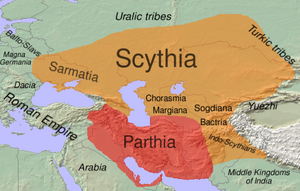Thyssagetae: Difference between revisions
No edit summary |
|||
| Line 1: | Line 1: | ||
[[Image:Scythia-Parthia 100 BC.png|thumb|300px|Map showing [[Scythia]], including the [[Indo-Scythian]] region ''(modern name Punjab region)''.]] | [[Image:Scythia-Parthia 100 BC.png|thumb|300px|Map showing [[Scythia]], including the [[Indo-Scythian]] region ''(modern name Punjab region)''.]] | ||
'''Thyssagetae''' (Hindi: थीस्सा-गेटाई , Ancient Greek: Θυσσαγέται) were an ancient tribe described by [[Herodotus]]<ref>Herodotus. Histories, 4.22. "...after the desert, if one inclines somewhat to the east, the Thyssagetae are reached, a numerous nation quite distinct from any other, and living by the chase."</ref> | '''Thyssagetae''' (Hindi: थीस्सा-गेटाई , Ancient Greek: Θυσσαγέται) were an ancient tribe described by [[Herodotus]]<ref>Herodotus. Histories, 4.22. "...after the desert, if one inclines somewhat to the east, the Thyssagetae are reached, a numerous nation quite distinct from any other, and living by the chase."</ref> | ||
== Variants == | |||
*[[Thyssagetæ]] ([[Natural History by Pliny Book VI/Chapter 7|Pliny.vi.7]]) | |||
== Location == | == Location == | ||
They were occupying a district to the north-east of [[Scythia]] (present-day [[Russia]]) separated from the [[Budini]] by a desert seven days journey broad. From their land four rivers flowed into the Maeotis, but as one of them, the [[Oarus]], is almost certainly the [[Volga]], there must be some mistake about this. They seem to have held the southern end of the [[Ural]]s about [[Ufa]] and [[Orenburg]]. | They were occupying a district to the north-east of [[Scythia]] (present-day [[Russia]]) separated from the [[Budini]] by a desert seven days journey broad. From their land four rivers flowed into the Maeotis, but as one of them, the [[Oarus]], is almost certainly the [[Volga]], there must be some mistake about this. They seem to have held the southern end of the [[Ural]]s about [[Ufa]] and [[Orenburg]]. | ||
Revision as of 16:12, 14 November 2022

Thyssagetae (Hindi: थीस्सा-गेटाई , Ancient Greek: Θυσσαγέται) were an ancient tribe described by Herodotus[1]
Variants
Location
They were occupying a district to the north-east of Scythia (present-day Russia) separated from the Budini by a desert seven days journey broad. From their land four rivers flowed into the Maeotis, but as one of them, the Oarus, is almost certainly the Volga, there must be some mistake about this. They seem to have held the southern end of the Urals about Ufa and Orenburg.
Ta-Yue-Che and Siao-Yue-Che
Bhim Singh Dahiya writes:
- "It is important to note that the Chinese word 'Yue-che" is pronounced as "Gut-tia" according to Karl-Gren, meaning the "Moon People".[2] Later on, the Chinese chronicles show, that under pressure of another tribe of the same stock, called by the Chinese as Hiung-nu or Hoa, the Yue-che moved southward and westward. The branch that was numerically weaker went to the South towards Tibet and were called 'Siao-Yue-Che", meaning the "little Yue-che". The main body moved westward and occupied Dahia (or Tahia, Bactria, Balkh). They were called "Ta-Yue-che" meaning the "Great Guttia" or great Jats. As shown above the word 'Yue-che' is pronounced as Guttia and therefore Ta-Yue-che is exactly the same as the word "Massa Getae" of the Greeks and the Persians. All the Chinese sources agree that the Kusanas were from the Yue-che race. The Chinese author of Thung-Kiang-Nu, writes in the year 555 A.D. that the Aptal or Hephthalites were of the race of Ta-Yue-che. Further the encyclopaedia of Ma-Tuan-g-Lin says that the Yeta are of the race of Ta-Yue-che, and further that the I-Tan belonged to the same race as Yue-che."[3]
Bhim Singh Dahiya goes on to state that:
- "The Chinese were right in stating that the Hiung-nu were a part of the Yue-Che (reads as Guti) people, and these Guti people had two divisions, the Ta-Yue-Che and the Siao-Yue-Che, exactly corresponding to the Massagetae and Thyssagetae of Herodotus (a classical Greek writer of fifth century BC), meaning the "Great-Jats" and the "Little-Jats" respectively. Almost every tribe of Ancient Middle East (West Asia) and Central Asia, is represented among the present day Jats in India."[4]
See also
External links
References
- ↑ Herodotus. Histories, 4.22. "...after the desert, if one inclines somewhat to the east, the Thyssagetae are reached, a numerous nation quite distinct from any other, and living by the chase."
- ↑ Jari-Churpentier, Die-Ethno Graphische Stellung der Toohaser, 1917, Pp. 347-388.
- ↑ Dahiya, Bhim Singh (1980): Jats, the ancient rulers: a clan study (First Edition: 1980). Sterling Publishers Pvt. Ltd. p. 25
- ↑ http://www.iranian.com/History/2005/March/Gutians/
Back to Variants of Jat

